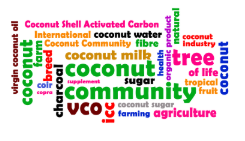Development of Coconut Palm Wood Seasoning Schedules
Abstract
Coconut palm is a versatile and commercially important palm in the tropical and sub-tropical regions. This study attempts to standardise moisture content-based kiln seasoning schedules for high-density and medium-densitycoconut palm wood and also understand relationship between Pilodyn Penetration Depth (PPD) and basic density for three density classes (high, medium and low). Quick drying test was conducted to study the degree and type of drying defects viz., surface cracking, end splitting, honeycombing and deformation. Defects were graded according to the Terasawa (1965) scale. The baseline parameters such as initial dry bulb temperature, final dry bulb temperature and the wet bulb depression for high and medium-density coconut palm wood were chosen by considering the major seasoning defects. The samples were subjected to different seasoning schedule treatments in a convection kiln to determine the best treatment based on grading of defects. The ideal drying period obtained for high-density coconut palm wood was 11 days, whereas for medium-density coconut palm wood it was 12 days. The schedule developed has good potential for industrial application in seasoning of coconut palm wood lumber with reduced defects in coconut growing regions of the world.
Keywords: Coconut palm wood, seasoning schedule, kiln drying, Terasawa scale
References
Bakar, E. S., Tahir, P. M., Sahri, M. H., Mohd Noor, M. S., & Zulkifli, F. F. (2013). Properties of resin impregnated oil palm wood (Elaeis guineensis Jack). Pertanika Journal of Tropical Agricultural Science, 36, 93–100.
Basri, E., Hadjib, N., & Saefudin, S. (2005). Basic properties in relation to drying properties of three wood species from Indonesia. Indonesian Journal of Forestry Research, 2(1), 49–56.
Basri, E., Saefudin, Rulliaty, S., & Yuniarti, K. (2009). Drying conditions for 11 potential ramin substitutes. Journal of Tropical Forest Science, 21(4), 328–335.
Brandão, A. T. D. O., & Jankowsky, I. P. (1992). A screening to select kiln schedules. IPEF Internacional, Piracicaba, 2, 20–24.
Coconut Development Board. (2016). Annual Report 2015-2016. Ministry of Agriculture & Farmers Welfare, Government of India.
Desch, H. E., & Dinwoodie, J. M. (1981). Timber: its structure, properties and utilisation. MacMillan Press Ltd.
Effah, B. (2014). Development of Kiln-Drying Schedules for two lesser-known timber species in Ghana. Journal of Science and Technology, 6(1).
Fathi, L., & Frühwald, A. (2014). The role of vascular bundles on the mechanical properties of coconut palm wood. Wood Material Science & Engineering, 9(4), 214–223.
Food and Agriculture Organization of the United Nations. (2019). Forest Futures: Sustainable Pathways for Forests, Landscapes and People in the Asia-Pacific Region. Food and Agriculture Organization.
Hoadley, R. B. (2000). Understanding wood: a craftsman’s guide to wood technology. Taunton Press.
International Tropical Timber Organization. (2010). Tropical Timber Market Report. ITTO Market Information Service.
International Tropical Timber Organization. (2017). Biennial review and assessment of the world timber situation 2015-2016.
International Tropical Timber Organization. (2020). Tropical Timber Market Report. ITTO Market Information Service.
Killmann, W. (1983). Some physical properties of the coconut palm stem. Wood Science and Technology, 17(3), 167–185.
Kumar, S., Kelkar, B. U., Mishra, A. K., & Jena, S. K. (2018). Variability in physical properties of plantation-grown progenies of Melia composita and determination of a kiln-drying schedule. Journal of Forestry Research, 29(5), 1435–1442.
Ofori, J., & Brentuo, B. (2010). Drying characteristics and development of kiln drying schedules for the wood of Alstonia boonei, Antrocaryou micraster, Bombax buonopozense, Dialium aubrevillei and Sterculia rhinopetala. Ghana Journal of Forestry, 26, 50–60.
Pryor, T. (2019). AHEC Jan-June 2019 Hardwood Export Report. American Hardwood Export Council.
Richolson, J. M., & Swarup, R. (2007). The anatomy, morphology, and physical properties of the mature stem of the coconut palm.
Simpson, W. (1991). Properties of wood related to drying: Dry kiln operator’s manual handbook.
Tan, Y. E., Lim, N. P. T., Gan, K. S., Wong, T. C., Lim, S. C., & Thilagwathy, M. (2010). Testing methods for plantation grown tropical timbers. Report of ITTO project on improving utilization and value adding of plantation timbers from sustainable sources in Malaysiano. Forest Research Institute, Malaysia.
Terazawa, S. (1965). Methods for easy determination of kiln drying schedule of wood. Japan Wood Industry, 20(5), 216–226.











